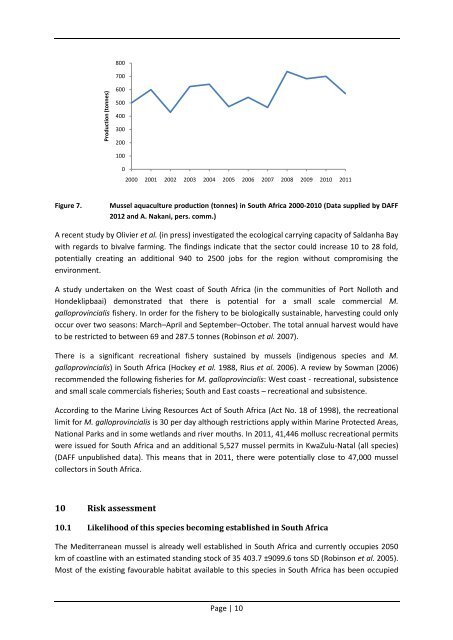Production (tonnes)80070060050040030020010002000 2001 2002 2003 2004 2005 2006 2007 2008 2009 2010 2011Figure 7.Mussel aquaculture production (tonnes) in South Africa 2000-2010 (Data supplied by DAFF2012 and A. Nakani, pers. comm.)A recent study by Olivier et al. (in press) investigated the ecological carrying capacity <strong>of</strong> Saldanha Baywith regards to bivalve farming. The findings indicate that the sector could increase 10 to 28 fold,potentially creating an additional 940 to 2500 jobs for the region without compromising theenvironment.A study undertaken on the West coast <strong>of</strong> South Africa (in the communities <strong>of</strong> Port Nolloth andHondeklipbaai) demonstrated that there is potential for a small scale commercial M.<strong>galloprovincialis</strong> fishery. In order for the fishery to be biologically sustainable, harvesting could onlyoccur over two seasons: March–April and September–October. The total annual harvest would haveto be restricted to between 69 and 287.5 tonnes (Robinson et al. 2007).There is a significant recreational fishery sustained by <strong>mussel</strong>s (indigenous species and M.<strong>galloprovincialis</strong>) in South Africa (Hockey et al. 1988, Rius et al. 2006). A review by Sowman (2006)recommended the following fisheries for M. <strong>galloprovincialis</strong>: West coast - recreational, subsistenceand small scale commercials fisheries; South and East coasts – recreational and subsistence.According to the Marine Living Resources Act <strong>of</strong> South Africa (Act No. 18 <strong>of</strong> 1998), the recreationallimit for M. <strong>galloprovincialis</strong> is 30 per day although restrictions apply within Marine Protected Areas,National Parks and in some wetlands and river mouths. In 2011, 41,446 mollusc recreational permitswere issued for South Africa and an additional 5,527 <strong>mussel</strong> permits in KwaZulu-Natal (all species)(DAFF unpublished data). This means that in 2011, there were potentially close to 47,000 <strong>mussel</strong>collectors in South Africa.10 Risk assessment10.1 Likelihood <strong>of</strong> this species becoming established in South AfricaThe <strong>Mediterranean</strong> <strong>mussel</strong> is already well established in South Africa and currently occupies 2050km <strong>of</strong> coastline with an estimated standing stock <strong>of</strong> 35 403.7 ±9099.6 tons SD (Robinson et al. 2005).Most <strong>of</strong> the existing favourable habitat available to this species in South Africa has been occupiedPage | 10
and it is unlikely that the range distribution will extend further eastward as the water temperatureincreases beyond that which is favourable for optimum growth <strong>of</strong> the species.In the case <strong>of</strong> other alien species, risk assessment pr<strong>of</strong>iles have been compiled, in which the specieshave been assessed in accordance with the European Non-Native Species Risk Analysis Scheme(ENSARS) (Copp et al. 2008) developed by CEFAS (UK Centre for Environment, Fisheries &Aquaculture Science). ENSARS provides a structured framework (Crown Copyright 2007-2008) forevaluating the risks <strong>of</strong> escape, introduction to and establishment in open waters, <strong>of</strong> any non-nativeaquatic organism being used (or associated with those used) in aquaculture. In the case <strong>of</strong> M.<strong>galloprovincialis</strong> which has established self sustaining populations along the coastline from theNamibian border to East London, further culturing <strong>of</strong> this species anywhere in this region is unlikelyto significantly affect the size <strong>of</strong> the current populations in any way. Aquaculture operationsprimarily rely on natural seeding from the <strong>of</strong>fshore larval pool. Where this is not the case, spat iscollected from local populations <strong>of</strong> the species. Currently no spat is imported into South Africa. As aresult <strong>of</strong> these culture techniques and the current distribution <strong>of</strong> the species, M. <strong>galloprovincialis</strong> hasnot been assessed using a risk scoring framework.10.2 Potential ecological impactsThe ecological effects following the invasion <strong>of</strong> M. <strong>galloprovincialis</strong> are most noticeable on the westcoast <strong>of</strong> South Africa where the lower intertidal zones <strong>of</strong> rocky shores have become inundated withvast, dense beds <strong>of</strong> the species. In comparison with the indigenous <strong>mussel</strong>s, C. meridionalis, A. aterand P. perna, M. <strong>galloprovincialis</strong> displays greater fecundity, growth rates and tolerance todesiccation (van Erkom Schurink & Griffiths 1992, Hockey & van Erkom Schurink 1992).Of the three indigenous species, A. ater is most severely affected by M. <strong>galloprovincialis</strong> as not onlydo they occupy similar sediment-free positions on the rocky shore, but their distribution rangesoverlap almost entirely (Branch & Steffani 2004). The impacts <strong>of</strong> this species on the abundance <strong>of</strong> C.meridionalis is thought to be much lower, as it is tolerant <strong>of</strong> sedimentation, occupying sandy areaswhere M. <strong>galloprovincialis</strong> is excluded. Similarly, effects on P. perna are thought to be minimal as theoverlap in their distribution ranges is small (South Coast only). Interactions between these twospecies are also supposedly more balanced, but should favour M. <strong>galloprovincialis</strong> owing to itshigher growth and reproductive performance, and the fact that P. perna is not a competitivelydominant species (Branch & Steffani 2004).Given that M. <strong>galloprovincialis</strong> <strong>mussel</strong> beds consist <strong>of</strong> multiple layers and can therefore support ahigher biomass per unit area than the indigenous species that only form single layers, a significantincrease in <strong>mussel</strong> biomass on West Coast has been noted following its introduction (Griffiths et al.1992). As a result, a simultaneous rise in the density <strong>of</strong> associated <strong>mussel</strong> bed infauna has alsooccurred (Hammond & Griffiths 2004). Furthermore, predators such as the whelk Nucella cingulataand the black oyster catcher Haematopus moquini (once a near-threatened species) have benefitedsignificantly from the increased food availability (Branch and Steffani 2004). The presence and highrate <strong>of</strong> recruitment <strong>of</strong> M. <strong>galloprovincialis</strong> in South Africa has also resulted in a loss <strong>of</strong> habitat for thecompetitively inferior native limpet Scutellastra granularis (Hockey & van Erkom-Schurink 1992, inPage | 11
















